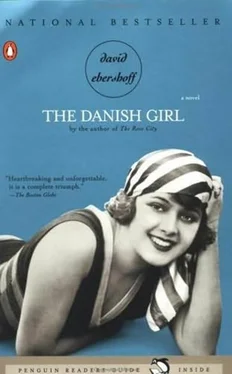They continued on to his office, into the windowless study behind the front room with the file cabinets where Hans looked up names for Greta to contact. He opened a folder and ran his finger down a list of patrons and said, “You should write him… and him… but be sure to avoid him. ” Standing next to Hans, Greta thought she felt a finger on her arm, but that was impossible because the file was open in both his hands. She thought she felt his touch again on the small of her back; but no, he hadn’t set down the file.
“Do you suppose we’ll be all right here?” she said.
A smile nearly cracked Hans’s lips. “What do you mean?”
“Einar and me? In Paris? Do you suppose we can get along here just fine?”
His smile disappeared. “Yes, of course. You have each other.” And then, “But don’t forget about me.” His face was leaning almost imperceptibly toward her. There was something between them-not the file, but something else. They said nothing.
But Hans can’t be for me, Greta thought. If anyone should have Hans, it should be Lili. Even though it was cool in the back office she suddenly felt warm and sticky, as if a moist film of dirt covered her. Had she done anything irreversibly wrong?
“I’d like you to become my dealer,” she said. “I’d like you to handle my paintings.”
“But I only deal in old masters and nineteenth-century pictures.”
“Maybe it’s time you took on a modern painter.”
“But that wouldn’t make any sense.” And then, “Listen, Greta, there ’s something I’ve been meaning to tell you.” He moved closer to her, the folder still in his hand. The light in the room was gray, and Hans looked like an adolescent not yet used to his new, larger body.
“Don’t say another word until you agree to take me on.” She didn’t want to, but she moved to the opposite side of the desk. In between Greta and Hans now lay a tabletop of paperwork. All at once she wanted to both let him hold her and to run back to the hotel room, across the Pont Neuf, where Einar was probably waiting, shivering by the stove.
“Let me put it this way,” she said. “I’m giving you the chance to take me on right now. If you decide not to, I’m sure you’ll regret it one day.” She was rubbing at the shallow scar in her cheek.
“How will I regret it?”
“You’ll regret it because one day you’ll say to yourself, I could have had her. That Greta Wegener could have been mine.”
“But I’m not turning you away,” Hans said. “Don’t you understand?”
But Greta did understand. Or at least she understood Hans’s intentions. What she couldn’t figure out was the hummingbird patter in her chest-why wasn’t she scorning Hans for making such an untoward advance? Why wasn’t she reminding him how much this would hurt Einar? Why couldn’t she even bring herself to say his name?
“Is it a deal?” she said.
“What?”
“Are you going to represent me? Or am I going to have to leave now?”
“Greta, be reasonable.”
“I think I am. This is the most reasonable response I can think of.”
They both stood leaning on their opposite ends of the desk. The stacks of documents were held down by bronze paperweights shaped like frogs. Everywhere she read his name, on the papers, over and over. Hans Axgil. Hans Axgil. Hans Axgil. It reminded her of when she was little and she had practiced her penmanship: Greta Greta Greta.
“I’ll do it,” he said.
“What?”
“Represent you.”
She didn’t know what to say. She thanked him and gathered her things. She offered her hand. “I suppose a handshake is in order,” she said. He took her hand, and there it was, her hand lost in the mitt of his, nearly trapped; but then he released her.
“Bring me some paintings next week,” he said.
“Next week,” and Greta stepped into the front room of Hans’s office, where the sunlight and the city noise poured through the windows, and the typewriter of a clerk clacked and clacked.

The smell of blood woke Einar. He got out of bed, careful not to disturb Greta. She looked uneasy, her face caught in a bad dream. The blood was trickling down his inner thigh, one slow hot line. A bubble of blood was caught in his nostril. He had woken as Lili.
In the spare bedroom, dawn fell on the pickled-ash wardrobe. Greta had given the top section to Lili. The bottom drawers were still Greta’s, shut with a hair lock. In the mirror, Lili saw her bloody nose, her nightshirt with the single stain of blood. She was unlike Greta. The blood never worried her, it came and went, and Lili would take to bed with it like a cold. To her, it was part of all this, she thought as she dressed-shimmying the skirt over her hips, brushing the static out of her hair. It was June, and a month had passed since Einar had decided, on the bench in the park, that his and Lili’s lives would have to part. Lili felt the threat of that, as if time were no longer endless.
At the Marché Buci the morning dew was drying. There were alleys and alleys of vendors, each with a stall protected by a zinc roof. The vendors were laying out their tables of cracked porcelain, their bureaus with the missing handles, their racks of clothes. One woman sold only ivory dice. A man had a collection of ballet slippers which he had a hard time parting with. There was a woman who sold fine skirts and blouses. She was in her forties, with short gray hair and chipped front teeth. Her name was Madame Le Bon, born in Algeria. Over the years she had come to know Lili’s taste, and she would hunt the death sales in Passy for the felt skirts Lili liked, and the white blouses with appliqué in the collar. Madame Le Bon knew Lili’s shoe size, knew she wouldn’t wear pairs that exposed her nailless toe. She bought camisoles for Lili that were small in the bust, and old-fashioned whalebone corsets that helped with that problem. She knew Lili liked crystal drop earrings and, for the winter, a rabbit-fur muff.
Lili was thumbing through Madame Le Bon’s rack when she noticed a young man with a high forehead looking at the picture books in the next stall. His topcoat was hanging over his arm, a canvas suitcase at his feet. He was standing at an odd angle, as if all his weight were on one foot. He seemed uninterested in the picture books, flipping through their pages and then looking at up Lili. Twice their eyes met; the second time he smiled.
Lili turned her back and held a plaid skirt up to her waist. “That’s a nice one,” Madame Le Bon said from her chair. She had created a little changing room by hanging bedsheets to a laundry line. “Try it on,” she said, holding back the sheet.
Inside the sun was bright through the sheets. The skirt fit well, and outside Lili heard a foreigner’s voice ask Madame Le Bon if she sold men’s clothes.
“Nothing for you, I’m afraid,” she said. “Only for your wife.”
The foreigner laughed. Lili then heard hangers being pushed along the pipe of a rack.
When she emerged from the stall, the man was folding and unfolding cardigans on a table. He fingered the pearly buttons and checked the cuffs for fray. “You have nice things,” he said, smiling first at Madame Le Bon and then at Lili. His blue eyes were big on his face; in the hollow of each cheek were one or two pocks. He was tall, and on the breeze was his aftershave, and Lili, closing her eyes, could imagine him pouring the yellow tonic into the cup of his hand and then slapping his throat. It was as if she already knew him.
Madame Le Bon logged the plaid skirt into her register. The man set down the cardigan and approached Lili with a gentle limp. “Excuse me,” he said in slow French. “Mademoiselle.” He shuffled toward Lili. “I was just noticing-”
Читать дальше













